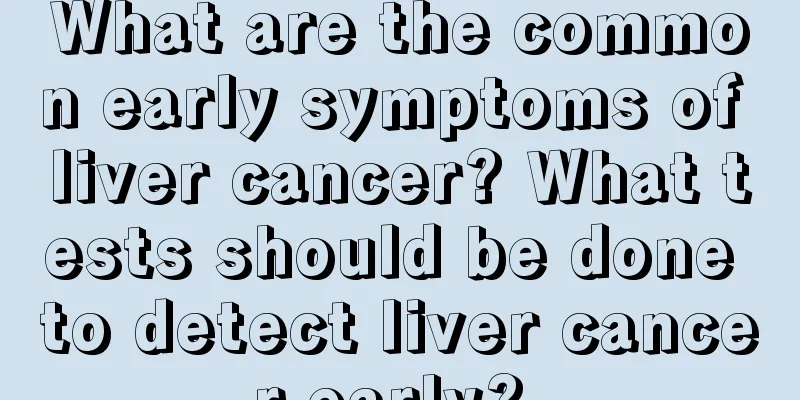What are the common early symptoms of liver cancer? What tests should be done to detect liver cancer early?

|
The liver is a very "strong" organ with powerful regeneration and reserve functions. Someone has done an experiment, and a mouse whose liver was cut off by 2/3 can restore its liver to normal size after 3 months. Therefore, even if it is eroded by cancer cells, the liver is constantly undergoing compensatory hyperplasia. Even if the liver has been eroded by more than half of the tumor cells, as long as 1/3 of the liver cells are functioning normally, the liver function test will not show abnormalities, and there will be no obvious discomfort in the body. This is why some patients with liver disease can eat and drink, have no pain or itching, and have no obvious symptoms, but when they are discovered, the malignant tumor on the liver is already as big as a fist. Due to the atypical symptoms of liver cancer in the early stages, it is often difficult to attract attention in the early stages. The main manifestations are fatigue, poor appetite, weight loss, abdominal distension, etc. without any inducement. Some patients may also have symptoms such as nausea, vomiting, fever, diarrhea, etc., which are often easily mistaken for digestive tract discomfort and are not taken seriously. As the disease progresses, late symptoms such as jaundice, ascites, lower limb edema, subcutaneous hemorrhage and cachexia appear. Therefore, people at high risk of liver cancer should pay enough attention when encountering similar discomfort symptoms, and seek medical examination and treatment in time. There are some atypical "signs" in the early stage of liver cancer Hypoglycemia: The liver itself has a strong compensatory ability. Only when the area of liver damage exceeds 70% to 80% will obvious hypoglycemia appear, manifested as dizziness, fatigue, sweating and other symptoms. Erythrocytosis: Patients with long-term cirrhosis or chronic liver disease who have an increase in erythrocytosis without other reasons may be an early sign of liver cancer and should be taken seriously. This is because when liver cancer cells divide, they produce a lot of erythropoietin, which leads to excessive red blood cell production. However, while liver cancer patients have an increase in erythrocytosis, their white blood cells, platelets, and lymphocytes do not increase. Therefore, the more red blood cells there are, the more vigorously the liver cancer cells divide. Clinical manifestations include flushed face and sanguineous appearance. Hyperlipidemia: Patients with cirrhosis and chronic hepatitis who have ruled out high-fat diet, heavy drinking, lack of exercise, and certain endocrine diseases but still have hyperlipidemia are also considered a sign of liver cancer. Clinically, it manifests as symptoms and signs of hyperlipidemia, such as obesity and atherosclerosis. What tests should be done to detect liver cancer early? Since liver cancer has no symptoms in its early stages, it is easily overlooked. Therefore, in order to detect early liver cancer, we have to rely on various examination methods. So, what examinations should be done to detect liver cancer in the early stages? 1. Ultrasound examination: B-ultrasound examination is economical and convenient. It can show the size, shape and location of the tumor, and the diagnostic accuracy rate is about 90%. The detection rate of liver lesions is also relatively high. Generally speaking, it takes about 4 to 6 months for liver cancer to grow from 1 cm to 3 cm. Therefore, if the first B-ultrasound liver cancer examination does not show liver cancer, take another examination 4 to 6 months later. The liver cancer should still be below 3 cm, and the treatment effect should be good. 2. CT: CT is a very important method for liver cancer examination, and it is widely used in China. However, when the diameter of liver cancer is less than 2 cm or the density is close to that of normal liver parenchyma, it is difficult to show it on CT. Liver cancer is diffuse and difficult to detect on CT; it is difficult to distinguish between primary and secondary liver cancer. 3. pET-CT: pET-CT is one of the examination items for early detection of liver cancer. Patients with hepatitis B and other conditions may consider the examination. pET-CT is a functional molecular imaging system that integrates pET and CT. It can not only accurately locate the anatomical location of the lesion through CT morphological imaging, but also reflect the biochemical metabolic information of the liver's space-occupying tissue through pET functional imaging. At the same time, whole-body scanning can understand the overall condition and evaluate the metastasis, so as to achieve the purpose of early detection of lesions. At the same time, it can understand the size and metabolic changes of the tumor before and after treatment. 4. Magnetic resonance imaging: Magnetic resonance imaging is a method of examination that has developed rapidly in recent years. In the past, MRI was not as ideal as CT examination. Now, with the continuous development of MRI technology, the scanning time is getting faster and faster, and the resolution is getting higher and higher. It can also make a relatively accurate judgment for some small lesions in the liver. Now MRI also plays a very important role in the examination of liver cancer. 5. Alpha-fetoprotein test: When ultrasound and/or CT scans are suspected of early liver cancer, an alpha-fetoprotein test is generally recommended for auxiliary diagnosis. Alpha-fetoprotein test is also one of the most common test methods to see if there are tumor markers. Alpha-fetoprotein has a certain sensitivity for the test, but we have also found in clinical practice that some patients may not have high alpha-fetoprotein levels. The alpha-fetoprotein level of liver cancer patients can be high, but patients with low alpha-fetoprotein levels cannot completely rule out the possibility of liver cancer. |
>>: What are the factors that induce lung cancer? Three factors that cause lung cancer
Recommend
What are the drugs for treating epididymitis
Epididymitis is a very common male disease and al...
How to treat mild schizophrenia? Three methods to teach you
Schizophrenia is a mental illness. In fact, schiz...
How to choose a good hospital for ovarian cancer in China
Ovarian cancer is a malignant tumor of the reprod...
Differential diagnosis of prostate cancer
Prostate cancer is a malignant disease that shoul...
What to do if urine smells bad
Perhaps many people will have such a situation, t...
What are the symptoms of bone development
Adolescence is the most important stage for bone ...
How to dye nails with peach blossom?
Nail peach blossom is also known as Impatiens or ...
Why do patients with cardia cancer experience pain
Cardia cancer is a special type of gastric cancer...
What to do if the corners of your mouth peel
Peeling of the corners of the mouth is a type of ...
What is the function of cellulase?
When it comes to cellulase, many people think it ...
How about Hawthorn, Cassia Seed and Corn Silk Dehumidifying Tea
Hawthorn, cassia seed, and corn silk are used to ...
How to treat breast cancer What should be paid attention to during the treatment of breast cancer
Breast cancer is the main killer of women in toda...
Can Niu Dali be soaked in water and drunk
The name Niudali contains the word "Niu"...
The reason why my hands feel numb after getting up
When we wake up every morning, we are most energe...
What causes the scalp to become hot and itchy?
When there is a lot of dandruff, our scalp will b...









